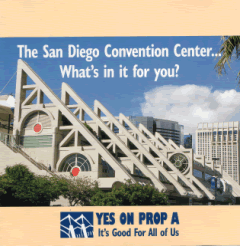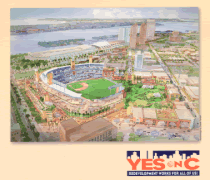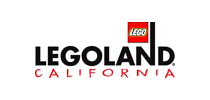Strong Mayor Initiative | San Diego, CA
Proposition D, 2010
Background
After securing voter-approval for a 5-year trial of the Strong Mayor governance system in 2004, we were responsible for passage of the 2010 initiative to make the reform permanent. The campaign occurred amid high levels of voter frustration with the city’s continuing financial problems and a lack of understanding among many voters for the significance of the change. Initial polling showed the initiative was supported by only a narrow plurality.
Strategy
Despite low levels of voter awareness or understanding of the governance change, certain messages related to the change resonated strongly with voters. These included increased accountability and a desire not to go back to a system that had been responsible for creating many of the city’s current financial problems. However, the initial polling also suggested that it would be very difficult to overcome a well-funded campaign by opponents, and several credible opponents signed the ballot argument against the initiative, including a popular council member and the president of the Police Officers Association.
We knew that there was significant correlation between support for the incumbent mayor and support for the initiative, so our communications strategy centered on highlighting the mayor’s progress in addressing the city’s financial problems, the increased accountability provided under the new system, and the consequences of returning to a discredited system that had helped create the city’s current problems. Opponents countered by claiming the initiative would increase the cost of governance, a powerful argument in light of the city’s shaky finances.
Unfortunately, campaign fundraising lagged, we were forced to cut back planned mail and television advertising, and a tracking poll completed two weeks before the election showed us trailing. Using these results to motivate donors, we were able to expand our mailing and television advertising over the final 10 days, using a new message from the head of the local Taxpayers Association to assure voters that the initiative would protect taxpayers.
Results
On Election Day, observers were surprised when the outcome – assumed to be too close to call – turned into a 60-40 landslide in support of the initiative. The final 10 days of mail and television were credited with turning the campaign around and making the Strong Mayor reform permanent.
Jerry Sanders’ Campaign for Mayor | San Diego, CA
2005
Background Mayor Dick Murphy’s announcement on April 25, 2005 that he would resign his office effective July 1 caught much of San Diego’s political establishment – and the local media – by surprise.
TS&A met with Jerry Sanders three days later to discuss his candidacy and explain the likely challenges, including the fact that he had never before sought public office, had no established network of campaign donors, and would have only 12 weeks to undertake a campaign before the July 26 special primary election.
Strategy (Primary) Knowing Sanders would be at a disadvantage to self-funded candidate Steve Francis, who had the resources to begin campaigning immediately, and to council member Donna Frye, who was better-known and just a few months earlier had narrowly lost a write-in campaign to Murphy, TS&A recommended a pre-emptive earned media strategy designed to increase public awareness of Sanders and his background, while reinforcing his position as an outsider in the race for mayor.
Results For four weeks in May, while his opponents were still planning their campaigns, Sanders defined his candidacy for voters, creating an image that eventually carried him to election as San Diego’s first strong mayor. We estimate the campaign earned approximately $2 million worth of media coverage during the month of May 2005, making Sanders’ under-funded primary campaign competitive with his opponents, and enabling his campaign to conserve limited resources for paid media over the final two weeks prior to the July 26 special election.
Strategy (Run-Off)
Finishing second to Frye in the primary, despite being outspent by a margin of over 4-to-1 by Francis, Sanders moved quickly to solidify support among former Francis voters while drawing clear distinctions between himself and opponent Frye. This included an aggressive fundraising effort that ultimately produced over $1 million in less than 12 weeks, and a rapid-response media strategy that left no charge unanswered and held his opponent accountable for her votes and conduct as a member of the city council. Successful fundraising efforts permitted the campaign to purchase three weeks of television advertising and produce direct mail for both absentee and election-day voters.
Results
Sanders overcame a 16-point primary deficit to defeat Frye 54-46, successfully carrying his base of Republican voters and 5 of 8 council districts (including Frye’s), but also showing considerable strength in council districts 4 and 8 which contain large numbers of Democratic and ethnic voters.

Convention Center Expansion | San Diego, CA
Proposition A, 1998
Background
In late 1997, the San Diego City Council adopted a financing plan for expansion of its bayfront convention center. A referendum petition forced the expansion to a public vote in the June 1998 ballot.
The convention center expansion was supported by the visitor industry and many local businesses. But voters viewed it skeptically because of controversy surrounding the just-completed Chargers lease agreement to expand Qualcomm Stadium.
Initial polling showed strong resentment and distrust of the city council. The convention center was recognized by most voters as important to the future of the visitor industry and the health of the local economy, but they distrusted the council’s competence and motives. The challenge facing Prop A supporters was to convince voters that visitors, not taxpayers, would be paying for the expansion. The opponents’ most persuasive argument was that taxpayers would ultimately end up footing the bill.
Strategy
Based on the polling, we developed a set of messages centering on benefits and safeguards. Messages included economic benefits, revenue benefits for local taxpayers, and assurances there would be no cost to taxpayers.
A speaker’s bureau was established with spokespeople from various business, labor and community groups. The speakers came not only from the visitors industry, but the local Restaurant Association, Chamber of Commerce, Taxpayers Association, community groups and the Labor Council. They made presentations to over 100 community groups and forums, featuring an informational video and standardized talking points on how the expanded convention center would be good for all San Diegans. We also produced four television ads and three radio ads. The campaign also placed endorsement ads in community papers throughout the city that listed local residents and businesses supportive of the measure.
Results
Despite a high-profile campaign against the measure funded by a local newspaper publisher, and lingering voter dissatisfaction over the city council’s handling of the San Diego stadium expansion, Prop A was approved by a landslide margin of 62% to 38%, and the lead-opponent was defeated soundly in his attempt to gain election to the city council. The mandate given Prop A, and subsequent reversal of public attitudes about development of public facilities, was credited with aiding passage six months later of Prop C for development of a downtown ballpark and redevelopment district adjacent to the expanded convention center.

Padres Ballpark & Redevelopment Initiative | San Diego, CA
1998
Background
We began working with owners of the San Diego Padres in August 1997 on a proposal for construction of a new ballpark. The Padres’ lease at Qualcomm Stadium was due to expire in 1999, and the team could not continue operating in the San Diego market without the revenues generated by a new facility.
The political climate was problematic for voter approval of a new ballpark because of the city council’s controversial 1996 agreement with the San Diego Chargers to expand Qualcomm Stadium and extend the Chargers’ lease, an agreement in which the city agreed to guarantee the sale of 60,000 general admission tickets for each Chargers’ home game.
Strategy
We recommended that any agreement for public financing of a new ballpark would need to be significantly different from the Chargers agreement, which was perceived by voters to have been a “back room” deal. We guided the team owners through a review process that included two citizen task forces, negotiations, city council approval of a Memorandum of Understanding, and a citywide election.
Based on initial public opinion research, we strongly recommended inclusion of the ballpark as part of a larger downtown redevelopment project, a project our research showed enjoyed much broader support than the ballpark alone. We recommended a full and open public review process prior to council approval of the agreement, clear limits in the agreement on public financing, and requirements that made the Padres responsible for ancillary development in the ballpark district and cost overruns in ballpark construction.
We further recommended that team owners step back and allow members of a citizens’ committee to act as spokespersons during the subsequent election campaign. We developed campaign messages that focused debate on the redevelopment project, and built a broad and diverse coalition of support for the measure.
Results
Daily public opinion tracking polls permitted us to make minor adjustments in message and targeting of television and direct mail over the final month of the campaign. Specifically, we were able to reverse low levels of support among voters 60 years and older by using television advertising to emphasize support for the project from police and fire fighters, and by direct mail targeted to women 35-54, who initially opposed the project but eventually supported it by a wide margin.
The result of these communications efforts was a larger-than-predicted 60% victory on Election Day. Approval of the ballpark marked the first time in U.S. history that such a facility was approved by voters on the first try.

Legoland Family Park Development | Carlsbad, CA
Proposition D, 1994
Background
When Danish toy manufacturer LEGO selected a 125-acre site in the City of Carlsbad for development of their first North American amusement park, government officials rejoiced about the impact the park would have on the state and local economies. But resident opposition – warning of traffic congestion and destruction of agricultural lands – soon threatened to de-rail the project.
The Carlsbad City Council promised to be bound by the results of an advisory measure on the June 1994 ballot. We were retained by a committee of local property owners, businesses and residents to run a campaign in support of the project.
Strategy
Our challenge was to demonstrate broad-based resident support for the project and convince voters the project would be a good neighbor that would contribute to rather than detract from their quality of life.
We recruited well-known and respected community members to take leadership roles in our campaign committee – Carlsbad CARES – and developed campaign materials that explained city-imposed conditions would funnel traffic directly on and off the freeway, avoiding impact on local streets, and ensured permanent preservation of the adjacent flower fields. We pointed out that over two-thirds of the Park would be landscaped open space, with the remainder hands-on education and entertainment facilities for young children and their families. We also emphasized the benefits of the project – 600 new jobs, $76 million annually for the region, and over $600,000 each year in revenues for the city.
An aggressive grass-roots campaign placed campaign signs in over 500 front yards; we secured personal endorsements from thousands of local residents; and an effective direct mail program carried our key messages to all likely voters.
Results
Our efforts proved crucial when, in the final two weeks of the campaign, a competing Southern California amusement park operator funneled over $100,000 into efforts to defeat the project. Despite their last-minute attacks, Carlsbad voters overwhelmingly approved what is now LEGOLAND, a regional visitor attraction and the foundation of the city’s surrounding development efforts.
